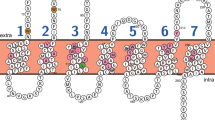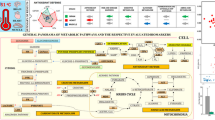Abstract
Physiological mechanisms involved in acclimation to variable salinity and oxygen levels and their interaction were studied in European flounder. The fish were acclimated for 2 weeks to freshwater (1‰ salinity), brackish water (11‰) or full strength seawater (35‰) under normoxic conditions (water Po2 = 158 mmHg) and then subjected to 48 h of continued normoxia or hypoxia at a level (Po2 = 54 mmHg) close to but above the critical Po2. Plasma osmolality, [Na+] and [Cl−] increased with increasing salinity, but the rises were limited, reflecting an effective extracellular osmoregulation. Muscle water content was the same at all three salinities, indicating complete cell volume regulation. Gill Na+/K+-ATPase activity did not change with salinity, but hypoxia caused a 25% decrease in branchial Na+/K+-ATPase activity at all three salinities. Furthermore, hypoxia induced a significant decrease in mRNA levels of the Na+/K+-ATPase α1-subunit, signifying a reduced expression of the transporter gene. The reduced ATPase activity did not influence extracellular ionic concentrations. Blood [Hb] was stable with salinity, and it was not increased by hypoxia. Instead, hypoxia decreased the erythrocytic nucleoside triphosphate content, a common mechanism for increasing blood O2 affinity. It is concluded that moderate hypoxia induced an energy saving decrease in branchial Na+/K+-ATPase activity, which did not compromise extracellular osmoregulation.




Similar content being viewed by others
References
Alam M, Frankel TL (2006) Gill ATPase activities of the silver perch, Bidyanus bidyanus (Mitchell), and golden perch, Macquaria ambigua (Richardson): effects of environmental salt and ammonia. Aquaculture 251:118–133
Baginsky ES, Foa PP, Zak B (1967) Determination of phosphate: study of labile organic phosphate interference. Clin Chim Acta 15:155–158
Bickler PE, Buck LT (2007) Hypoxia tolerance in reptiles, amphibians, and fishes: Life with variable oxygen availability. Annu Rev Physiol 69:145–170
Booth JH (1979) The effects of oxygen supply, epinephrine, and acetylcholine on the distribution of blood flow in trout gills. J Exp Biol 83:31–39
Chang IC, Hwang PP (2004) Cl- uptake mechanism in freshwater-adapted tilapia (Oreochromis mossambicus). Physiol Biochem Zool 77:406–414
Evans DH, Piermarini PM, Potts WTW (1999) Ionic transport in the fish gill epithelium. J Exp Zool 283:641–652
Flik G, Kaneko T, Greco AM, Li J, Fenwick JC (1997) Sodium dependent ion transporters in trout gills. Fish Physiol Biochem 17:385–396
Hawkings GS, Galvez F, Goss GG (2004) Seawater acclimation causes independent alterations in Na+/K+- and H+-ATPase activity in isolated mitochondria-rich cell subtypes of the rainbow trout gill. J Exp Biol 207:905–912
Hochachka PW, Lutz PL (2001) Mechanism, origin, and evolution of anoxic tolerance in animals. Comp Biochem Physiol 130B:435–459
Jensen FB (2004) Red blood cell pH, the Bohr effect, and other oxygenation-linked phenomena in blood O2 and CO2 transport. Acta Physiol Scand 182:215–227
Jensen MK, Madsen SS, Kristiansen K (1998) Osmoregulation and salinity effects on the expression and activity of Na+, K+-ATPase in the gills of European sea bass, Dicentrarchus labrax (L.). J Exp Zool 282:290–300
Jensen FB, Lecklin T, Busk M, Bury NR, Wilson RW, Wood CM, Grosell M (2002) Physiological impact of salinity increase at organism and red blood cell levels in the European flounder (Platichthys flesus). J Exp Mar Biol Ecol 274:159–174
Jørgensen JB, Mustafa T (1980) The effect of hypoxia on carbohydrate metabolism in flounder (Platichthys flesus L.)–I. Utilization of glycogen and accumulation of glycolytic end products in various tissues. Comp Biochem Physiol 67B:243–248
Katoh F, Hasegawa S, Kita J, Tagaki Y, Kaneko T (2001) Distinct seawater and freshwater types of chloride cells in killifish, Fundulus heteroclitus. Can J Zool 79:822–829
Kiilerich P, Kristiansen K, Madsen SS (2007) Hormone receptors in gills of smolting Atlantic salmon, Salmo salar: expression of growth hormone, prolactin, mineralocorticoid and glucocorticoid receptors and 11beta-hydroxysteroid dehydrogenase type 2. Gen Comp Endocrin 152:295–303
Kültz D, Somero GN (1995) Osmotic and thermal effects on in situ ATPase activity in permeabilized gill epithelial cells of the fish Gillichthys mirabilis. J Exp Biol 198:1883–1894
Lai JCC, Kakuta I, Mok HOL, Rummer JL, Randall D (2006) Effects of moderate and substantial hypoxia on erythropoietin levels in rainbow trout kidney and spleen. J Exp Biol 209:2734–2738
Lin H, Randall D (1993) H+-ATPase activity in crude homogenates of fish gill tissue: inhibitor sensitivity and environmental and hormonal regulation. J Exp Biol 180:163–174
Lowry OH, Rosebrough NJ, Farr AL, Randall RJ (1951) Protein measurement with the Folin reagent. J Biol Chem 193:265–275
Madsen SS, McCormick SD, Young G, Endersen JS, Nishioka RS, Bern HA (1994) Physiology of seawater acclimation in the striped bass, Morone saxatilis (Walbaum). Fish Physiol Biochem 13:1–11
Madsen SS, Jensen MK, Nohr J, Kristiansen K (1995) Expression of Na+-K+-ATPase in brown trout, Salmo trutta: In vivo modulation by hormones and seawater. Am J Physiol Regul Integr Comp Physiol 269:R1339–R1345
Madsen SS, Larsen BK, Jensen FB (1996) Effects of freshwater to seawater transfer on osmoregulation, acid-base balance and respiration in river migrating whitefish (Coregonus lavaretus). J Comp Physiol B 166:101–109
Marshall WS (2002) Na+, Cl-, Ca2+ and Zn2+ transport by fish gills: retrospective review and prospective synthesis. J Exp Zool 293:264–283
Maxime V, Peyraud-Waitzenegger M, Claireaux G, Peyraud C (1990) Effects of rapid transfer from sea water to fresh water on respiratory variables, blood acid-base status and O2 affinity of haemoglobin in Atlantic Salmon (Salmo salar L.). J Comp Physiol B 160:31–39
McCormick SD (1993) Methods for nonlethal gill biopsy and measurement of Na + , K + -ATPase activity. Can J Fish Aquat Sci 50:656–658
Nonnotte G, Truchot JP (1990) Time course of extracellular acid-base adjustments under hypo-or hyperosmotic conditions in the euryhaline fish Platichthys flesus. J Fish Biol 36:181–190
Olsvik PA, Lie KK, Jordal AE, Nilsen TO, Hordvik I (2005) Evaluation of potential reference genes in real-time RT-PCR studies of Atlantic salmon. BMC Mol Biol 6:21
Perry SF (1998) Relationships between branchial chloride cells and gas transfer in freshwater fish. Comp Biochem Physiol 119A:9–16
Richards JG, Semple JW, Bystriansky JS, Schulte PM (2003) Na+/K+-ATPase α-isoform switching in gills of rainbow trout (Oncorhynchus mykiss) during salinity transfer. J Exp Biol 206:4475–4486
Richards JG, Wang YS, Brauner CJ, Gonzalez RJ, Patrick ML, Schulte PM, Choppari-Gomes AR, Almeida-Val VM, Val AL (2007) Metabolic and ionregulatory responses of the Amazonian cichlid, Astronotus ocellatus, to severe hypoxia. J Comp Physiol B 177:361–374
Sampaio LA, Bianchini A (2002) Salinity effects on osmoregulation and growth of the euryhaline flounder, Paralichthys orbignyanus. J Exp Mar Biol Ecol 269:187–196
Seidelin M, Brauner CJ, Jensen FB, Madsen SS (2001) Vacuolar-type H+-ATPase and Na+, K+-ATPase expression in gills of Atlantic salmon (Salmo salar) during isolated and combined exposure to hyperoxia and hypercapnia in fresh water. Zool Sci 18:1199–1205
Soivio A, Tuurala H (1981) Structural and circulatory responses to hypoxia in the secondary lamellae of Salmo gairdneri gills at two temperatures. J Comp Physiol 145:37–43
Stagg RM, Shuttleworth TJ (1982) Na+, K+-ATPase, ouabain binding and ouabain-sensitive oxygen consumption in gills from Platichthys flesus adapted to seawater and freshwater. J Comp Physiol 147:93–99
Tipsmark CK, Madsen SS, Borski RJ (2004) Effect of salinity on expression of branchial ion transporters in striped bass (Morone saxitilis). J Exp Zool 301A:979–991
Uchida K, Kaneko T, Yamauchi K, Hirano T (1996) Morphometrical analysis of chloride cell activity in the gill filaments and lamellae and changes in Na+, K+-ATPase activity during seawater adaptation in chum salmon fry. J Exp Biol 276:193–200
Wilson JM, Laurent P (2002) Fish gill morphology: inside out. J Exp Zool 293:192–213
Wood CM, Kajimura M, Sloman KA, Scott GR, Walsh PJ, Almeida-Val VMF, Val AL (2007) Rapid regulation of Na+ fluxes and ammonia excretion in response to acute environmental hypoxia in the Amazonian oscar, Astronotus ocellatus. Am J Physiol Regul Integr Comp Physiol 292:R2048–R2058
Zar JH (1984) Biostatistical analysis, 2nd edn. Prentice-Hall, Englewood Cliffs
Acknowledgments
The work was supported by the Danish Natural Science Research Council. Annie Bach is thanked for technical support.
Author information
Authors and Affiliations
Corresponding author
Additional information
Communicated by I.D. Hume.
Rights and permissions
About this article
Cite this article
Lundgreen, K., Kiilerich, P., Tipsmark, C.K. et al. Physiological response in the European flounder (Platichthys flesus) to variable salinity and oxygen conditions. J Comp Physiol B 178, 909–915 (2008). https://doi.org/10.1007/s00360-008-0281-9
Received:
Revised:
Accepted:
Published:
Issue Date:
DOI: https://doi.org/10.1007/s00360-008-0281-9




